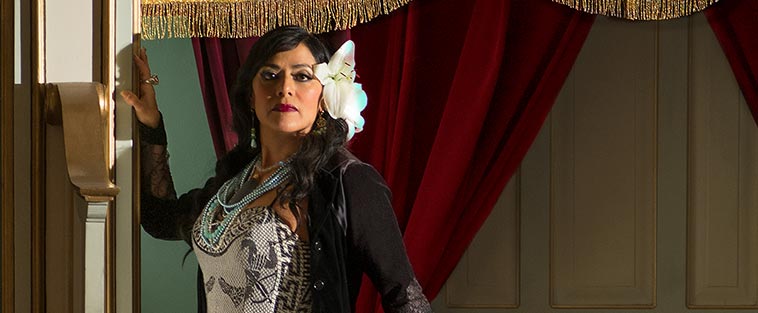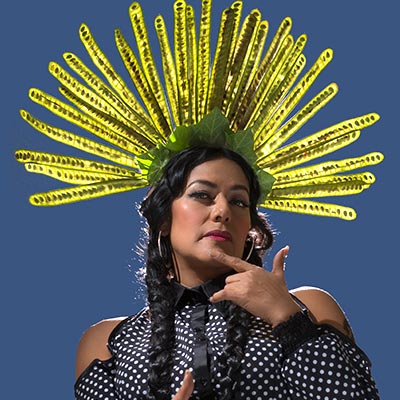
By Web Behrens
Lila Downs sings in many languages, but her listeners need only be fluent in the language of the heart to understand her.
You can hear it throughout her new release, Salón Lágrimas y Deseo (Room of Tears and Desire), just released at the end of May. “It’s also the most emotional album we’ve ever done,” Downs observes. “It’s not from the brain; it’s from the heart. And”—she adds with a modest chuckle—“from below.”
That’s most obvious in the closing track, “Peligrosa.” As she does throughout the entire album, Downs sings in Spanish, but you don’t have to understand a single lyric to appreciate the stakes in this duet between her and another singer, Mon Laferte. Backing them is a second duet, between strings and brass, raising the stakes as the orchestration and vocals build. This ballad contains pain, passion and courage. These women’s voices tell a story: They know life can be (as the title says) “Dangerous,” yet they will not be intimidated.
No surprise, then, that the song is about women fighting back against male domination. “To be a dove and to be peligrosa as well—they’re kind of similar,” observes Downs. “Some of the lyrics say, ‘You are no longer my master. I am master of my destiny now. This is my body, and I do what I want to it.’ ”
In talking about the song, which also appears on the album in a solo version, the singer-songwriter begins to muse about various ways people can express pride and agency in their physicality. “You know, I had these tattoos done on my arms, and I thought, ‘Why am I doing this? I’m going to turn 50 this year!’ ” (Downs’s big five-oh arrives in early September.) But she stopped second-guessing her choice after she saw photos showing off the ink, which courses over her fit arms. “You know, tattoos mean different things to different people. They’re about ritual; they’re about sexual expression. They can be about power and domination; disturbing but also sexual.” It’s clear Lila Downs doesn’t shy away from complicated topics. Sex, politics, love, racism: She’s willing to talk and, more to the point, compose music about it all. She’s also blessed with a knockout voice, her range spanning from lilting soprano to smoky alto. The resulting combination has led to a career spanning more than two decades, earning Downs one Grammy, four Latin Grammys and fans around the world.
It’s clear Lila Downs doesn’t shy away from complicated topics. Sex, politics, love, racism: She’s willing to talk and, more to the point, compose music about it all. She’s also blessed with a knockout voice, her range spanning from lilting soprano to smoky alto. The resulting combination has led to a career spanning more than two decades, earning Downs one Grammy, four Latin Grammys and fans around the world.
Born to Anastasia Sanchez, a Mixtec woman, and Allen Downs, a Minnesota man, Lila has dual citizenship. Although she doesn’t consider herself a polyglot, she’s fluent in Spanish and English, can speak a bit of Mixtec, and has performed songs in other Mesoamerican languages, including Zapotec and Nahuatl. “My roots are complex,” she says in her seemingly signature speech, a measured, straightforward choice of words.
In many ways, her identity has been shaped by a wide variety of seemingly oppositional components, and Downs has forged a role as a go-between, straddling various worlds. Her mother was a singer; her father, a professor. She grew up both in Oaxaca and Minneapolis/Saint Paul; as an adult, she’s made a home in both of North America’s two largest metropolises, Mexico City and New York City. Her upbringing drew from the worlds of the arts as well as from academia; as a student, she studied both voice and anthropology.
Befitting a person who’s carved out a bold artistic career, music is central to her life. It’s what brought her parents together. “My mother was performing in a little club in Mexico City,” Downs explains, “and my dad came through there when he was working on a documentary about the blue-winged teal, which migrates from Canada to the Yucatan Peninsula.”
Although her dad’s academic world back north was significantly different from the clubs of Mexico City, young Lila wasn’t deprived of the arts while in the United States. Her father taught film and painting at the University of Minnesota in the ’70s, so she had plenty of exposure to culture, particularly visual art. And, of course, she benefited from a dual musical heritage. “My father listened to jazz, a lot of Miles Davis—and then there was Janis Joplin,” she recalls. “My mother listened to José Alfredo Jiménez and Lola Beltrán, so very traditional [Mexican] music.” Later, Downs studied classical music; that’s another element she’s incorporated into her eclectic music identity.
But there’s always the call of roots music—easily noticed in her choice of kickoff track: “Urge,” by prominent 20th-century composer Martin Urieta. Even for those whose ears are geared to the gringo aural spectrum, it’s not hard to notice a similar, thrilling drive between Mexican folk-pop and klezmer, the folk music of Eastern European Jews. “Klezmer definitely is one of those musical genres I’m constantly in love with,” Downs admits. “Roots music is the thing. It makes you feel! That’s the beauty of music: You look to music that gives the voice you need to find.”
Downs credits the powerful force of music with rescuing her—from grief, from anger. She was just 16 when her father died, which is enough to throw anyone into a tailspin. Meanwhile, she was trying to make sense of her mixed-race heritage. It wasn’t even as simple as her Mexican side not being accepted by some white Americans; as she explains, the Mixtec aren’t always held in proper regard by other Mexicans. “My mother spoke a Native American language that nobody respected, and I couldn’t figure out why. So I embarked on a mission of finding out who I was, as many young people do,” she says.
“My Native American side is very much denied in all of this continent,” Downs continues. “That’s still the story in the music and in the expression of self.” By using her artistry to explore these issues, Downs says, “Music really did save my life.” Not that she believes she’s unique in that regard, adding, “It probably does for many people.”

But Downs also had some unique tools to explore any thorny questions of ethnicity and identity that many musicians don’t, having studied cultural anthropology in addition to taking voice classes at the University of Minnesota. No wonder she can tackle topics regarding identity, migration, and social justice in her songwriting.
Still, Downs has a humble side. When met with a remark about her unique preparations for her career, she responds by making connections to another musician. “I remember reading at one point that Tracy Chapman also studied anthropology,” she notes. “Her vision and her songs are a little bit similar, I guess. She’s a soulful performer, and also a complicated one.”
She hasn’t collaborated yet with Chapman; maybe that’s still to come. In the past, she’s worked with a wide range of musicians, including Carlos Santana, Wynton Marsalis, Carla Morrison, and the renowned Mercedes Sosa, one of her musical idols. Downs has a special appreciation for a duet that appears on her 2008 release, Shake Away. A revered Argentinian singer, Sosa recorded “Tierra De Luz” with Downs near the end of her five-decade-long career. Downs recalls feeling “very lucky” to have had the opportunity. “She died not even a year afterwards,” Downs continues. “That was very touching—I admired and respected her so much.”
Downs intends to record a second new album this year—in English—and she’s got a few North American musicians in mind when asked whom she’d love to work with. Topping the list? “Neil Young — probably like many other people.” Tom Waits and Rufus Wainwright are also on her list. “Hopefully we’ll have luck.” Having moved south of the border two years ago, after calling NYC home for a decade, Downs currently lives with an extended family in both Oaxaca and Mexico City. Her husband and son, her mother, and her niece all live together. But that’s not all, says Downs: “We have a nana who comes from another Native American community, and sometimes her mother comes and stays. And my uncles—et cetera, et cetera. It’s a party down there!”
Having moved south of the border two years ago, after calling NYC home for a decade, Downs currently lives with an extended family in both Oaxaca and Mexico City. Her husband and son, her mother, and her niece all live together. But that’s not all, says Downs: “We have a nana who comes from another Native American community, and sometimes her mother comes and stays. And my uncles—et cetera, et cetera. It’s a party down there!”
But events in the United States have brought a lot of anger, doubt, and confusion to our Mexican neighbors: specifically, the divisive candidacy and election of Donald Trump. “To tell you the truth, just like with a lot of Latino people in the US, there’s a lot of disbelief” that he could win the presidency, Downs says. “I guess it’s good, in a way, because we suddenly have to acknowledge the fact that, yes, a lot of people don’t like us. I don’t think we were dealing with that. It makes us come together and redefine ourselves.
“I don’t know how good that will be for him”—Downs avoids saying his name—“or for the haters in the long run. It’s going to carry its consequences.”
The artist felt so strongly about opposing the man, she wrote and recorded a song last October, both in English and Spanish: “The Demagogue”/“El Demagogo.” First performed at a unity concert at the US–Mexico border in San Diego, the songs include lyrics such as “There’s a blue-eyed devil man / Thinks he's king of the world / He’s a bully, a salesman / Selling fear and hate.”
When asked if she had any fears about repercussions for such an outspoken stance, she says she didn’t think twice about recording the song. But recently, when crossing the border, “It did come to mind,” she says. “If somebody out there decides that I can’t perform [in the US], well, it wouldn’t surprise me. I think things are really nuts right now.”
She’s got no plans to change her tune, figuratively or literally—hardly a surprise from a woman who does a good amount of humanitarian work too. (Among other things, she’s been an ambassador for Amnesty International and Save the Children, as well as a spokesperson for Fondo Guadalupe Musalem, a group promoting education of girls in Oaxaca.) “I think it’s important to speak truths about people who hate,” she says.
That’s part of the goal of her brand-new album, Salón Lágrimas y Deseo. On one hand a mix of original songs and covers that recall the people’s music in 20th-century dance halls, there’s a message behind the passion. “It’s about love and longing, and our contradictions as human beings,” she reveals. “Showing how people can have depth, in spite of being confronted with people who are smaller than themselves.”
That sounds like a message she could have used years ago, when she was, by her own admission, a “difficult and rebellious teen.” From her perspective today, is there any advice she would want to share with young Lila?
She pauses for a moment to reflect before answering—then holds forth with another piece of well-earned wisdom. “Well, I don’t know if I would say it’s going to be okay, because that would steer that Lila away from the need to express a lot of her anger and frustration—and love—which a lot of adolescents have,” she says. “I guess I would say: Keep doing what you’re doing. In the end, it let to this, to where I am today.”
A native of the Windy City, Web Behrens covers arts, culture, and travel for the Chicago Tribune and Crain’s Chicago Business. He’s also worked as an editor and contributor for Time Out Chicago and the Chicago Reader.
